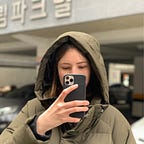The Human Senses: Presentation.
“Present how you were able to be aware of your group regardless of distance in an interactive class experience”
Group members 🤝: Damul Yang, Maria Carolina, Sebastian Ervi, Maria Shuttleworth
<<< Part 1 of this project found here: The Human Senses: And so it begins…
We narrowed down the experiences that we felt created the best feeling of togetherness, so that we could present our ideas to the class in an interactive form.
Idea one: Cafe togetherness.
Even though it was completely unplanned (sometimes the best things are), we loved the feeling of togetherness having our lunch together created.
Points we can recreate for the class:
- Bring coffee to share in paper cups
- Display picture of a cafe interior on main screen
- Cafe background noise (youtube)
- Group conversation about something relatable (e.g. family, weather, London)
Idea two: Fun fair experience.
Working off last week’s balance experiments, we transformed “walking across a bench with our eyes closed, using the vibrations on string to know which way to walk”, into a game you might see at the fun fair.
Main points to recreate:
- Guide a volunteer around the room with string, keeping their eyes closed
- The volunteer follows a route we lay out on the floor
- Amusement park music playing in the background
- Two group members holding string wear black to “disappear”; other two dress in bright colours, replicating fun fair uniforms.
- Audience participation: cheering + booing
- Reward at the end (individually wrapped sweets)
Presentation: The Fun Fair Experience.
After our tutorial with John, we decided to focus on the fun-fair experience, as it is an easier experience to communicate. We all met up before class to work on finalising everything.
1. Tickets & Treats
Damul brought sweets to give out as rewards, and we drew out two tickets for the game.
2. Layout
Before class started, we set up the route on the floor with masking tape. The aim of the layout was to follow the line from top to bottom, avoiding traps (x’s). I drew up these floor plans to visualise it beforehand so we could plan it better.
Initially we started next to the door, but after testing it with Sylvester (who had also arrived early) it turned out to be too difficult. We then started from the middle of the room, but it was too boring! So, we put in a kink in the maze, as well as another trap, and were finished.
3. Final Presentation
Unfortunately Damul had to leave before the presentation due to circumstances that were out of her control, so we continued as a 3-person-group.
Sebastian acted as the host, introducing the ride in his suit & bow-tie, with the thematic music playing in the background. Meanwhile, the two Marias stood in the background waving the tickets about.
Remembering that the initial experiment mainly involved balance (walking along one line), we involved more senses:
- Touch: holding the string to feel vibrations, letting Max know which way to walk
- Proprioception: Max’s sense of space helping him figure out where he is with closed eyes
- Sound: fun fair music playing in the background + audience participation (cheering to encourage, shouting “danger” to warn of a trap)
- Taste: candy reward for participating
Final thoughts
This experiment worked well. The idea was well understood by the volunteers, leading it to run smoothly.
John and Alistair noted that there was a bit of a disconnect between the fun fair theme we had set out on screen, the music and our performance, that the host could have been more engaging, and mine and Maria’s disappearance into the background wasn’t quite so clear.
If we could do this again I would want to script more dialogue for the host, and get them to ask more follow-up questions to the participant. Also, the two people designated to hold the string should be dressed in black to “disappear” (couldn’t be managed as Damul was dressed in black, but unfortunately had to leave).
Next project on the Skin in my next post: The Skin: A big think >>>
References.
- Lupton, E. and Lipps, A., 2018. The Senses. New York: Copper Hewitt, Smithsonian Design Museum.
- Yanagisawa, H., Miyazaki, C. and Bouchard, C., 2017. KANSEI MODELING METHODOLOGY FOR MULTISENSORY UX DESIGN. Proceedings of the 21st International Conference on Engineering Design (ICED17), 8: Human Behaviour in Design, Vancouver, Canada, 21.-25.08.2017
